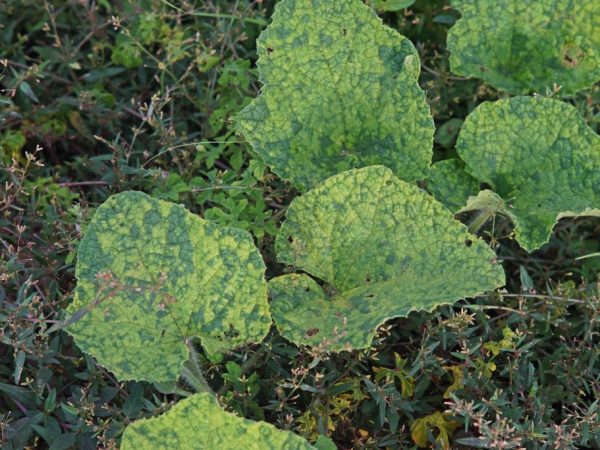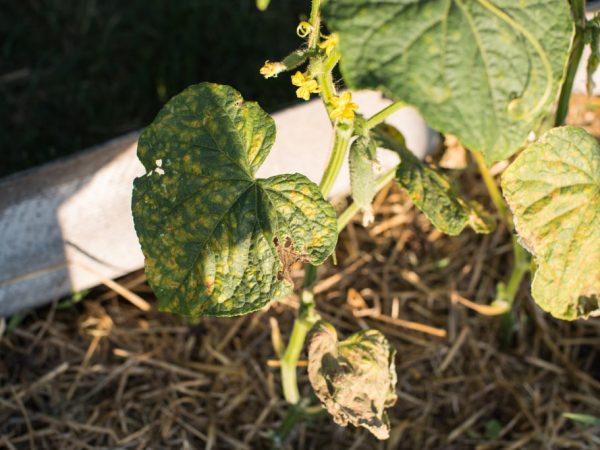How to deal with spider mites on cucumbers
Spider mites on cucumbers are a fairly frequent phenomenon, and although most gardeners take some measures to combat this pest, they often turn out to be insufficient or ineffective. Let's figure out how to deal with spider mites on cucumbers.

Fighting spider mites on cucumbers
Tick harm
Crop pests cause significant damage to plants. These insects settle on the very plants or in the ground, damaging the roots, leaves, fruits, which negatively affects the yield.
The pest is not dangerous to humans, but destructive to cucumbers. The spider mite sucks the cucumber juice from the leaves of the culture, while photosynthesis is impaired. If the disease progresses during fruiting, the ovary and cucumbers are affected. The plant's immunity decreases, it becomes vulnerable to various infections, gradually dries up and finally dies.
The affected culture is susceptible to gray rot, since favorable conditions for its emergence develop.
All terrestrial organs are in a deplorable state, the cucumber predator affects even fruits.
Spider mites on cucumbers are an alarm signal for vegetable growers. If you do not take any measures to combat a dangerous predator, after a while you will have to deal with the spider mite on cucumbers throughout the entire area.
Symptoms of the disease
The mite appears and begins to multiply exclusively in an environment with high temperatures and increased dry air. For the winter, the pest climbs into dry leaves, the top layer of soil, manure and greenhouses, especially loves to hide in the corners.
What signs indicate the presence of insects and how can they be recognized? The symptoms of the appearance of a dangerous enemy of cucumbers are as follows:
- the appearance of light dots on the back of the sheet;
- slowing down the growth of culture;
- yellowing of the leaves.
The presence of at least one sign should alert the gardener. Lost time will cost the plants their lives, so you need to fight right away.
Preventive measures
Instead of choosing the best way to get rid of a tick infestation on cucumbers in the future, it is better to think about how to prevent it. There are several methods of dealing with dangerous insects. Experienced vegetable growers recommend a number of agrotechnical measures:
- after harvesting, the stems, leaves and roots of plants are destroyed;
- before sowing cucumbers, the soil is carefully dug up, since for the winter, before the plants appear, pests hide in the ground;
- weeds are regularly removed and destroyed, since the insect lives on them;
- the affected leaves are regularly cut off, and then buried or burned;
- sow crops after favorable predecessors: various types of cabbage and tomatoes;
- it is not recommended to use the same plot for cultivation for several years in a row.
When the first symptoms of a pest are detected, gardeners should treat the plantings with biological products.Some vegetable growers effectively use folk measures to combat a dangerous enemy.
Chemicals

All insecticides are very dangerous to humans.
What means will help rid cucumbers of spider mites? Some gardeners treat plantings with insecticides, but these drugs do not bring much benefit. Insectoacaricides and acaricides will allow you to destroy a dangerous enemy, but these funds must be used carefully, since they are very dangerous to human health.
Experienced vegetable growers give preference to preparations of intestinal contact action, and this allows you to cope with pests. The processing of the site must be carried out several times. The frequency of use of drugs directly depends on the air temperature: the higher it is, the more often it is necessary to carry out treatment against dangerous insects. Good results in the fight against them can be obtained using the following drugs:
- Plant pin. The drug is used to destroy the pest in greenhouses. The stick is simply stuck into the ground for a while, and it protects green spaces from disease.
- Etisso. The drug acts in the same way as the previous one, but consists of another active substance, kills the enemy in the soil and on plants, acts quickly and effectively.
- Actellic has a good effect, but is harmful to the human body and belongs to the second class of hazardous substances. It is used only when other drugs have failed. It should be used very carefully, using respiratory and skin protection (goggles, respirator, gloves). The drug is sold in ampoules, which, after opening, must be used throughout the day. After spraying, the skin is thoroughly washed with soap and water. After processing, fruits can be eaten no earlier than 2 weeks later.
- Fitoferm brings good results only when other preparations are used alternately with it: the insect quickly gets used to the insecticide.
- Aktofit is used to combat the enemy in both indoor and outdoor conditions.
Good results are brought by Karbofos, Iskra-BIO, Bitoxybacillin. Processing is carried out in the evening, when the heat subsides, in calm and dry weather.
Biological agents
The safest and most effective biological control method is the phytoseilus mite. The predator destroys the eggs of the spider pest.
- Phytoseilus is placed on cultures adjacent to lesions.
- You need to plant it every 20 days.
Traditional methods
Folk remedies for spider mites have been used for many years. Experienced vegetable growers use all recognized control methods:
- treatment of cultures with a soap solution;
- resettling flowering plants, for example, dill (ladybugs flock to its inflorescences, which destroy pests);
- settling the beds with the Adjarian entomophthora mushroom.
Remedies for spider mites on cucumbers can stop the development of the disease. If the lesions are very large, it will not be possible to completely defeat the enemy. The cultures are treated with the preparations indicated above.
Prophylaxis
It is not easy, and sometimes impossible, to protect plantings from these insects and fight them: they are very resistant to insecticides and folk remedies, they are carried even by gusts of wind, and therefore there is always the possibility that the treatment will be useless. The only correct decision is to carry out preventive measures that will protect crops from a dangerous enemy.
The defeat of cucumbers by spider mites in greenhouses occurs much more often than in open ground. Greenhouse conditions are the ideal habitat for him. That is why it is extremely difficult to fight him in a greenhouse on cucumbers and tomatoes. It is necessary to increase the humidity in the greenhouse (over 60%). This method is an excellent prevention and control method at the same time.
Preventive measures also include disinfection (fumigation) of the greenhouse in late autumn and early spring. After harvesting, the top layer of soil is removed and replaced in the greenhouse. The tapestries are fired with a gas burner. It is also recommended to use preparations containing phosphorus to feed plants: this will increase their immunity to disease.
Conclusion
Fighting the cucumber mite of vegetable crops is quite difficult. Timely prevention plays an important role in this matter. Agrotechnical measures taken on time, constant monitoring of the state of plantings, timely treatment with various preparations in combination with folk methods allow to protect plants from pests. And this is a prerequisite for a good harvest, which all vegetable growers and gardeners dream of.


